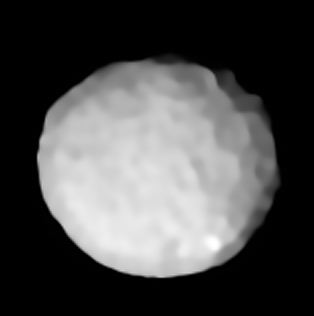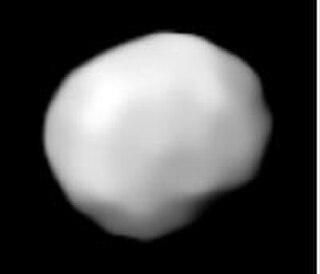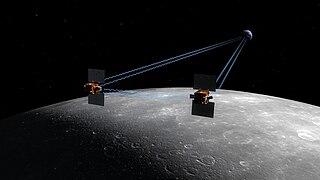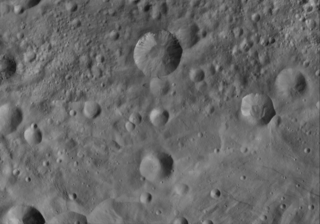
Vesta is one of the largest objects in the asteroid belt, with a mean diameter of 525 kilometres (326 mi). It was discovered by the German astronomer Heinrich Wilhelm Matthias Olbers on 29 March 1807 and is named after Vesta, the virgin goddess of home and hearth from Roman mythology.

Pallas is the third-largest asteroid in the Solar System by volume and mass. It is the second asteroid to have been discovered, after Ceres, and is a likely remnant protoplanet. Like Ceres, it is believed to have a mineral composition similar to carbonaceous chondrite meteorites, though significantly less hydrated than Ceres. It is 79% the mass of Vesta and 22% the mass of Ceres, constituting an estimated 7% of the mass of the asteroid belt. Its estimated volume is equivalent to a sphere 507 to 515 kilometers in diameter, 90–95% the volume of Vesta.

Dawn is a retired space probe that was launched by NASA in September 2007 with the mission of studying two of the three known protoplanets of the asteroid belt: Vesta and Ceres. In the fulfillment of that mission—the ninth in NASA's Discovery Program—Dawn entered orbit around Vesta on July 16, 2011, and completed a 14-month survey mission before leaving for Ceres in late 2012. It entered orbit around Ceres on March 6, 2015. In 2017, NASA announced that the planned nine-year mission would be extended until the probe's hydrazine fuel supply was depleted. On November 1, 2018, NASA announced that Dawn had depleted its hydrazine, and the mission was ended. The derelict probe remains in a stable orbit around Ceres.

704 Interamnia is a large F-type asteroid. With a mean diameter of around 330 kilometres, it is the fifth-largest asteroid, after Ceres, Vesta, Pallas and Hygiea. Its mean distance from the Sun is 3.067 AU. It was discovered on 2 October 1910 by Vincenzo Cerulli, and named after the Latin name for Teramo, Italy, where Cerulli worked. Its mass is probably between fifth and tenth highest in the asteroid belt, with a mass estimated to be 1.2% of the mass of the entire asteroid belt. Observations by the Very Large Telescope's SPHERE imager in 2017–2019, combined with occultation results, indicate that the shape of Interamnia may be consistent with hydrostatic equilibrium for a body of its density with a rotational period of 7.6 hours. This suggests that Interamnia may have formed as an equilibrium body, and that impacts changed its rotational period after it fully solidified.

NASA's 2003 Mars Exploration Rover Mission has amassed an enormous amount of scientific information related to the Martian geology and atmosphere, as well as providing some astronomical observations from Mars. This article covers information gathered by the Opportunity rover during the initial phase of its mission. Information on science gathered by Spirit can be found mostly in the Spirit rover article.

Ceres is a dwarf planet in the middle main asteroid belt between the orbits of Mars and Jupiter. It was the first known asteroid, discovered on 1 January 1801 by Giuseppe Piazzi at Palermo Astronomical Observatory in Sicily, and announced as a new planet. Ceres was later classified as an asteroid and then a dwarf planet, the only one inside Neptune's orbit.

The Gravity Recovery and Interior Laboratory (GRAIL) was an American lunar science mission in NASA's Discovery Program which used high-quality gravitational field mapping of the Moon to determine its interior structure. The two small spacecraft GRAIL A (Ebb) and GRAIL B (Flow) were launched on 10 September 2011 aboard a single launch vehicle: the most-powerful configuration of a Delta II, the 7920H-10. GRAIL A separated from the rocket about nine minutes after launch, GRAIL B followed about eight minutes later. They arrived at their orbits around the Moon 25 hours apart. The first probe entered orbit on 31 December 2011 and the second followed on 1 January 2012. The two spacecraft impacted the Lunar surface on December 17, 2012.
Vassilis Angelopoulos is a Greek American physicist. He is a specialist on space and astrophysical plasmas.
David A. Hodell is a British–American geologist and paleoclimatologist. In October 2008, Hodell was appointed to the position of Woodwardian Professor of Geology at the University of Cambridge in the United Kingdom, where he is also a fellow of Clare College. He is a dual citizen of the United Kingdom and the United States. He is also the Director of the Godwin Laboratory for Palaeoclimate Research. Previously, he taught at the University of Florida from 1986–2008, earning the rank of full professor in geological sciences. Hodell was also the director of the Stable Isotope Laboratory from 1996–2008. Hodell earned his Ph.D. in 1986 in oceanography from the University of Rhode Island after earning his bachelor of arts in 1980 in geology from the University of Vermont.

Rheasilvia is the largest impact crater on the asteroid Vesta. It is 505 km (314 mi) in diameter, which is 90% the diameter of Vesta itself, and is 95% the mean diameter of Vesta, 529 km (329 mi). However, the mean is affected by the crater itself. It is 89% the mean equatorial diameter of 569 km (354 mi), making it one of the largest craters in the Solar System, and at 75°S latitude, covers most of the southern hemisphere. The peak in the center of the crater is 200 km (120 mi) in diameter, and rises 22.5 km from its base, making it one of the tallest mountains known in the Solar System.

David John Southwood is a British space scientist who holds the post of Senior Research Investigator at Imperial College London. He was the President of the Royal Astronomical Society from 2012–2014, and earlier served as the Director of Science and Robotic Exploration at the European Space Agency (2001–2011). Southwood's research interests have been in solar–terrestrial physics and planetary science, particularly magnetospheres. He built the magnetic field instrument for the Cassini Saturn orbiter.

Margaret Galland Kivelson is an American space physicist, planetary scientist, and distinguished professor emerita of space physics at the University of California, Los Angeles. From 2010 to the present, concurrent with her appointment at UCLA, Kivelson has been a research scientist and scholar at the University of Michigan. Her primary research interests include the magnetospheres of Earth, Jupiter, and Saturn.

Alexander J. Dessler was an American space scientist known for conceiving the term heliosphere and for founding the first Space Science Department in the United States.
Roger Jay Phillips was an American geophysicist, planetary scientist, and professor emeritus at the Washington University in St. Louis. His research interests included the geophysical structure of planets, and the use of radar and gravity to investigate the surfaces and interiors of the planets.
Amy C. Clement is an atmospheric and marine scientist studying and modeling global climate change at the University of Miami's Rosenstiel School of Marine, Atmospheric, and Earth Science.
Tuija I. Pulkkinen is a Finnish space physicist. Her primary research foci are studying the energy flow from the solar wind to the near-Earth space environment and the energy dissipation processes in the magnetosphere.
The International Union of Geological Sciences (IUGS) is the internationally recognized body charged with fostering agreement on nomenclature and classification across geoscientific disciplines. However, they have yet to create a formal definition of the term "planet". As a result, there are various geophysical definitions in use among professional geophysicists, planetary scientists, and other professionals in the geosciences. Many professionals opt to use one of several of these geophysical definitions instead of the definition voted on by the International Astronomical Union, which is the governing body that astronomers recognize when it comes to nomenclature.
Mary Hudson is the Eleanor and Kelvin Smith Distinguished Professor of Physics at Dartmouth College. She is known for her research on the weather patterns that occur due to solar eruptions. She was elected a fellow of the American Geophysical Union in 1984.

Vestalia Terra is a large highland plateau on the giant asteroid Vesta. Situated in Vesta's eastern hemisphere, Vestalia Terra is located near the equator and hosts the tallest point on Vesta. One of the largest named features on Vesta, it contains some of the most ancient terrain known on the asteroid.











